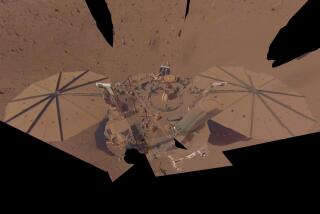Rosetta spots two types of water ice on the surface of comet 67P
Water is abundant in comets, both in the nucleus and the surrounding cloud of gas. But even though scientists are sure it’s there, finding signs of it on the surface has been a surprisingly difficult task.
This week, a team examining data collected by the European Space Agency’s Rosetta spacecraft announced it has finally identified two large patches of water ice on the surface of comet 67P Churyumov-Gerasimenko, perhaps the most studied comet in history.
The elusive ice was detected in a region known as Imhotep, on the bottom part of the main lobe of the dumbbell-shaped comet. It was located on cliff walls and debris falls, and appeared as noticeably bright patches in visible light, according to a paper published this week in Nature.
“It looked like there was a breakage, or something fell down on the surface of the comet, and a large, new inside area that had water ice was exposed,” said Murthy Gudipati, a planetary scientist at the Jet Propulsion Laboratory in La Cañada Flintridge and one of the paper’s authors.
Scientists have spotted traces of water ice on comets before. NASA’s Deep Impact mission found it in relatively small patches on the surface of the two comets it surveyed, Hartley 2 and Tempel 1. But there was much less of it than researchers had anticipated.
“At the time we thought there would be exposures of ice everywhere,” said Jessica Sunshine, a co-investigator on the Deep Impact mission and a planetary scientist at the University of Maryland, who was not involved in the latest study. “What we learned is that comets are much more dynamic systems than we ever imagined.”
The surface of 67P, like most comets, is mainly covered by materials that are so dark they appear almost black. That’s because as comets fly toward the sun, they are exposed to warm temperatures that cause surface ice to sublimate, or transform directly from solid to gas. What remains are materials similar to rocks, sand and ash on Earth, said Michael Combi, who studies comets at the University of Michigan and co-wrote the report.
“This paper shows us that some of the ideas we had about comets are right,” said Paul Weissman, who studies comets at the Planetary Science Institute in Tucson. “The findings are consistent with what we know about other comets, but it’s nice to see it here because the resolution is much better than what Deep Impact had.”
Data collected by Rosetta’s Visible Infrared and Thermal Imaging Spectrometer, known as VIRTIS, revealed that the water ice grains in the Imhotep region came in two different sizes.
Some of the grains were tiny, just tens of micrometers across. These probably formed as a result of the comet’s 12-hour rotation. As this region of the comet turns away from the sun, the temperature drops low enough for water ice to condense out of the coma and onto the nucleus, creating a thin layer of frost, the authors wrote. During the “day” on the comet surface, temperatures increase and the water evaporates back into the coma.
VIRTIS also detected evidence of this frost-like surface ice in the neck region of the comet.
The larger ice grains, which are a few millimeters across, probably have a more complex origin story, the study authors said.
The members of the team, led by Gianrico Filacchione of the Institute for Space Astrophysics and Planetology in Rome, posit that this ice is forged in the interior of the nucleus, where emptiness prevails. As the comet flies closer to the sun and the ice in the shallow subsurface vaporizes, some of the water might sink into the voids in the cooler, lower layers. Once there, it may condense again and form larger grains.
“Keep in mind that comets are very porous, like cotton candy,” Gudipati said. “Seventy percent of this comet is a void, and because of that, the heat from the surface does not go that deep.”
One conclusion from this research is that the structure of comets can change over time, said Neil Dello Russo, a planetary astronomer at Johns Hopkins Applied Physics Laboratory who was not involved in the new study.
“The layered features seen on 67P and perhaps Tempel 1 may be more likely due to comet evolutionary and sublimation processes, and may not reflect how the comet was originally formed,” he said.
Filacchione and his colleagues are now analyzing more recent data captured by the VIRTIS instrument to see how the amount of ice exposed on the surface changed as the comet zoomed closer to the sun.
“That’s Rosetta’s great advantage,” Sunshine said. “It orbited this comet as it moved toward the sun and back away again.”
Twitter: @DeborahNetburn






